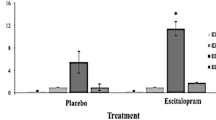Abstract
Fifteen normal volunteers were administered 0.250, 0.375, and 0.500 mg of triazolam and placebo in a double-blind repeated measures cross-over design. Subjects demonstrated dose-dependent impairments in free recall, a test of explicit memory requiring awareness and reflection, and sedation as assessed by objective behavioral measures (the digit symbol substitution task) and subjective visual analogue scales. The sedative drug response did not account for the impairment in free recall. Differences in performance of the two tests of sedation indicated that the effect of this drug on reflective processes accounts for impairment in episodic memory and the inability to track the sedative effects of this drug at the higher doses tested in this study.
Similar content being viewed by others
References
Bond A, Lader M (1974) The use of analogue scales in rating subjective feelings. Br J Med Psychol 47:211–218
Craik RIM, Morris LW, Morris RG, Loewen ER (1990) Relations between source amnesia and frontal lobe functioning in older adults. Psychol Aging 5[1]:148–151
Cummings JL (1993) Frontal-subcortical circuits and human behavior. Arch Neurol 50:873–880
Curran HV (1986) Tranquillising memories: a review of the effects of benzodiazepines on human memory. Biol Psychol, 23:179–213
Curran HV, Schiwy W, Lader M (1987) Differential amnesic properties of benzodiazepines: a dose-response comparison of two drugs with similar elimination half-lives. Psychopharmacology, 92:358–364
Danion J-M, Zimmermann M-A, Willard-Schroeder D, Grange D, Singer L (1989) Diazepam induces a dissociation between explicit and implicit memory. Psychopharmacology 99:238–243
Danion JM, Zimmermann MA, Willard SD, Grange D et al. (1990) Effects of scopolamine, trimipramine and diazepam on explicit memory and repetition priming in healthy volunteers. Psychopharmacology 102(3):422–424
Fang JC, Hinrichs JV, Ghoneim MM (1987) Diazepam and memory: Evidence for spared memory function. Pharmacol Biochem Behav 28:347–352
File SE, Sharma R, Shaffer J (1992) Is lorazepam-induced amnesia specific to the type of memory or to the task used to assess it? J Psychopharmacol 6:76–80
Ghoneim MM, Hinrichs JV, Mewaldt SP (1984) Dose-response analysis of the behavioral effects of diazepam: I Learning and memory. Psychopharmacology 82:291–295
Ghoneim MM, Dembo JB, Block RI (1989) Time course of sedative and amnesic effects of diazepam by flumazenil. Anesthesiology 70:899–904
Hommer DW, Matsuo V, Wolkowitz H, Chrousos G, Greenblatt D, Weingartner H, Paul S (1986) Benzodiazepine sensitivity in normal human subjects. Arch Gen Psychiatry 43:542–551
Lister RG (1985) The amnesic action of benzodiazepines in man. Neuroscience and Biobehavioral Reviews 9:87–94
Lister RG, Weingartner H (1987) Neuropharmacological strategies for understanding psychobiological determinants of cognition. Human Neurobiol 6:119–127
Molchan SE, Hill A, Weingartner HJ, Mellow JL, Vitello B, Martinez R, Sunderland T (1992a) Increased cognitive sensitivity to scopolamine with age and a perspective on the scopolamine model. Brain Res Rev 17:215–226
Molchan SE, Mellow MA, Hill JL, Weingartner HJ, Martinez R, Vitiello B, Sunderland T (1992b) The effect of thyrotopin-releasing hormone and scopolamine in Alzheimer's disease and normal volunteers. J Psychopharmacol 6[4]:489–500
Moscovitch M (1989) Confabulation and the frontal systems: strategic versus associative retrieval in neuropsychological theories of memory. In: Roediger IHL, Craik FIM (eds) Varieties of memory and consciousness: Essays in honour of Endel Tulving. Erlbaum, Hillsdole, pp. 133–160
Norris H (1971) The action of sedatives on brain stem oculomotor systems in man. Neuropharmacology 10:181–191
Petrides M (1989) Frontal lobes and memory. In: Boller F, Grafman J (eds) Handbook of neuropsychology. Elsevier, New York, pp 75–90
Schacter DL (1987) Implicit memory: history and current status. J Exp Psychol [Learn Mem Cognit 13:501–518
Shallice T (1988) From neuropsychology to mental structure Cambridge University Press, Cambridge
Sherry DF, Schacter DL (1987) The evolution of multiple memory systems. Psychol Rev 94:439–454
Squire LR, Zola MS (1988) Memory: brain systems and behavior. special issue: learning and memory. Trends Neurosci 11[4]:170–175
Tulving E (1987) Multiple memory systems and consciousness. Human neurobiology 6:67–80
Tulving E, Schachter DL (1990) Priming and human memory systems. Science 247:301–306
Wechsler D (1955) Wechsler adult intelligence scale manual. Psychological Corporation, New York
Weingartner H, Buchsbaum MS, Linnoila M (1983a) Zimelidine effects on memory impairments produced by ethanol. Life Sci 33[22]:2159–2163
Weingartner H, Grafman J, Boutelle W, Kaye W, Martin PR (1983b) Forms of memory failure. Science 221[4608]:380–382
Weingartner HJ, Eckardt M, Hommer D, Wolowitz O (1991) Specificity of memory impairments with triazolam use. Lancet 338:883–884
Weingartner HJ, Hommer D, Lister RG, Thompson K, Wolkowitz O (1992) Selective effects of triazolam on memory. Psychopharmacology 106:341–345
Weingartner HJ, Joyce EM, Sirocco KY, Adams CM, Eckardt MJ, George T, Lister RG (1993) Specific memory and sedative effects of the benzodiazepine triazolam. J Psychopharmacol 7(4):305–315
Wolkowitz OM, Weingartner H, Thompson BS, Pickar D, Paul SM, Hommer DW (1987) Diazepam-induced amnesia: a neuropharmacological model of an “organic amnestic syndrome.” Am J Psychiatry 144:25–29
Author information
Authors and Affiliations
Rights and permissions
About this article
Cite this article
Weingartner, H.J., Sirocco, K., Rawlings, R. et al. Dissociations in the expression of the sedative effects of triazolam. Psychopharmacology 119, 27–33 (1995). https://doi.org/10.1007/BF02246050
Received:
Revised:
Issue Date:
DOI: https://doi.org/10.1007/BF02246050




